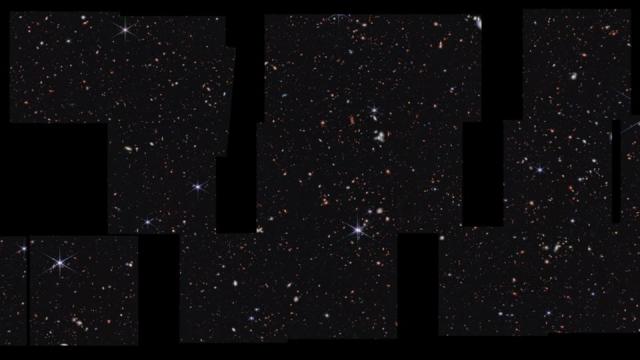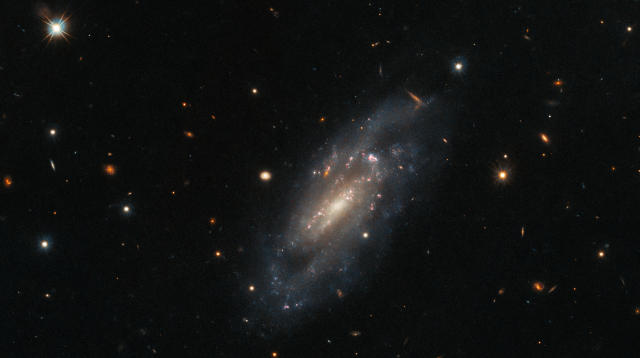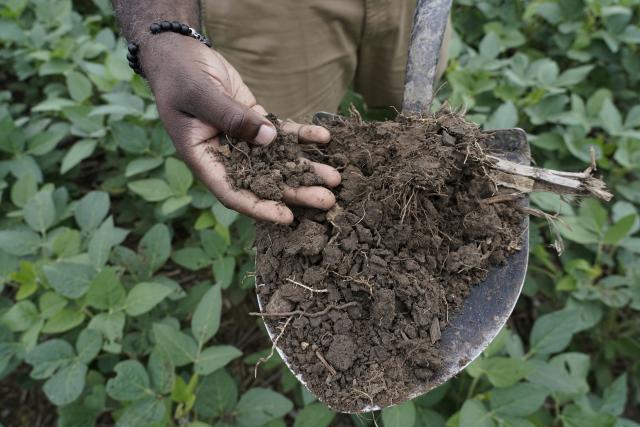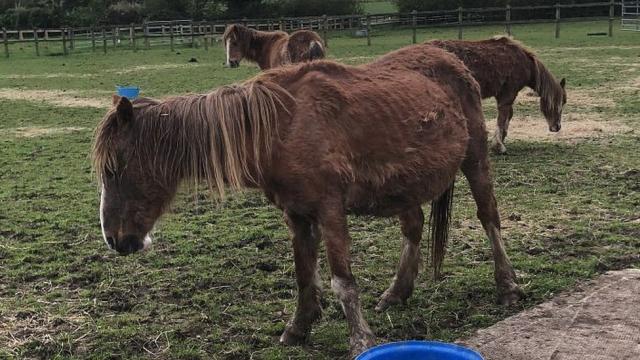Science Daily News | 17 Jul 2023

Views (90)

Webb telescope spots a supermassive black hole formed more than 13 billion years ago
The James Webb Space Telescope has delivered yet another astounding discovery, spying an active supermassive black hole deeper into the universe than has ever been recorded.

The black hole lies within CEERS 1019 — an extremely old galaxy likely formed 570 million years after the big bang — making it more than 13 billion years old. And scientists were perplexed to find just how small the celestial object’s central black hole measures.
That’s “far less than other black holes that also existed in the early universe and were detected by other telescopes,” according to NASA. “Those behemoths typically contain more than 1 billion times the mass of the Sun – and they are easier to detect because they are much brighter.”
“Looking at this distant object with this telescope is a lot like looking at data from black holes that exist in galaxies near our own,” Rebecca Larson, who received her doctorate from the University of Texas at Austin this year, said in a statement. Larson, who led this discovery, is now a postdoctoral research associate at the Rochester Institute of Technology’s School of Physics and Astronomy.
Not only did the researchers pinpoint this fascinating black hole — they also discovered two others nearby that appear to have been formed about 1 billion years after the big bang and were also lightweight compared with others of that period.
Eleven new galaxies were also recorded with evidence from Webb’s Cosmic Evolution Early Release Science, or CEERS, Survey, also led by the University of Texas at Austin.
The galaxy CEERS 1019 has other interesting attributes. It appears as a string of three bright spots, for example, rather than a singular disk-shaped formation of many other galaxies.
“We’re not used to seeing so much structure in images at these distances,” CEERS team member Jeyhan Kartaltepe of the Rochester Institute of Technology in New York, said in a statement. “A galaxy merger could be partly responsible for fueling the activity in this galaxy’s black hole, and that could also lead to increased star formation.”
The newly discovered galaxies are still spewing out new stars, according to NASA. And these findings, along with others from the CEERS survey, may lead to fascinating breakthroughs.
“Webb was the first to detect some of these galaxies,” said Seiji Fujimoto, a NASA Hubble Fellow at UT Austin who was part of the University of Texas at Austin team that discovered 11 new galaxies, in a statement. “This set, along with other distant galaxies we may identify in the future, might change our understanding of star formation and galaxy evolution throughout cosmic history.”
Researchers also note that the black hole within CEERS 1019 may only remain the most distant active supermassive black hole ever recorded for a brief time.
The astronomical community is already pouring over data that could pinpoint other, more distant black holes. It could do so in just a “few weeks,” according to NASA.
Isle of Man sends digital stamps on data storing mission to the Moon
A set of stamps is being sent to the Moon on a mission to explore how data centres work in space.

Digital Manx stamps are to be sent to the Moon on a mission to discover how data centres work in space.
Digital Isle of Man and space data storage company Lonestar are taking part in NASA's Commercial Lunar Payload Services programme.
It aims to explore how data could be stored on the Moon and retrieved should a catastrophe take place on earth.
Enterprise Minister Tim Johnston said the island was building on its "history of innovation in the space sector".
The possibilities this technology could bring were "hugely exciting", and the project was an example of the island participating in "pioneering new developments for businesses", he said.
A government spokeswoman said the initiative was using expertise in the island's blockchain industry to "digitise exclusive stamps that will be posted to the Moon and back" via Lonestar's lunar data centre.
Lonestar CEO Chris Stott said he felt "enormously privileged to be able to run such a novel mission from my home".
He said: "We could not do this without the island and its unique commitment to disaster recovery, space, and the global digital economy."
The government spokeswoman said the digital stamps, which each feature a different version of the triskelion flag, would be verified and tracked on the return trip to the Moon, and the trail would become part of a digital footprint.
They would then be transmitted back to the Earth as part of the larger Artemis lunar exploration programme mission, she said.
Hubble telescope captures stunning shot of spiral galaxy (photo)
A dazzling new photo from the Hubble Space Telescope shows a distant galaxy that hosted a supernova explosion not long ago.

A dazzling new photo from the Hubble Space Telescope shows a distant galaxy that hosted a supernova explosion not long ago.
"The hugely energetic processes during supernova explosions are predominantly responsible for forging the elements between silicon and nickel on the periodic table," NASA officials said in the statement. "This means that understanding the influence of the masses and compositions of the progenitor star systems is vital to explaining how many of the chemical elements here on Earth originated."
RELATED STORIES:
Observations of supernova remnants like the one in UGC 11860 can help astronomers learn more about the star systems that fuel such cosmic explosions.
Super-close supernova captivates record number of citizen scientists
Data from the closest cosmic supernova explosion to Earth for 10 years was collected by a record number of observers for SETI, showing what the collective power of citizen scientists can achieve.

The closest cosmic explosion to Earth in the last 10 years became a record breaker for the Search for Extraterrestrial Intelligence (SET) Institute.
The effort involved 123 dedicated amateur astronomers making 252 observations with 115 telescopes following how light from the supernova changed over time, first seeing its escalating brightness and then tracking its gradual fading. This allowed the SETI scientists to build a profile for the supernova that astronomers called a light curve, a measurement of its brightness over time.
RELATED STORIES:
Participants receive real-time alerts when transient events are spotted, resulting in the rapid initiation of observing campaigns such as the one seen for (SN) 2023ixf. As they monitor the increase in brightness and subsequent fading of cataclysmic events, volunteers help scientists to gather vital details about the objects behind these violent and powerful celestial occurrences and their impact on surrounding gas and dust, known as interstellar material.
The program will get a major boost next year when the Vera C. Rubin Observatory in Chile commences operations, allowing the Unistellar network of citizen astronomers to team up with other crews of astronomers and professional astronomers to study transient events.
Farm fields don't just feed us. They store carbon. But a big question is how much
When Al Schafbuch cut back on plowing his Iowa fields decades ago and later began growing cover crops, he was out to save money on fertilizer and reduce erosion. There's one more big payoff that benefits everyone: tilling the soil less, and growing more cover crops, can help farmers store more planet-warming carbon in fields. More plants take in more carbon dioxide, and soil microbes breathe out less carbon when undisturbed.

DYSART, Iowa (AP) — When Al Schafbuch cut back on plowing his Iowa fields decades ago and later began growing cover crops, he was out to save money on fertilizer and reduce erosion. He got those benefits and saw his soil change for the better, too: dark, chunky, richly organic matter that he said feels like “chocolate cake."
There's one more big payoff that benefits everyone: tilling the soil less, and growing more cover crops, can help farmers store more planet-warming carbon in fields. More plants take in more carbon dioxide, and soil microbes breathe out less carbon when undisturbed. That can mean money for participating farmers in the form of carbon offsets — payments that companies can make that support carbon storage in farms and, in theory, balance out their emissions elsewhere.
“The more carbon you store from the atmosphere with your crops, and the more crops grown throughout the year, you offset some of your waste, your wasted energy,” said Shalamar Armstrong, an associate professor of agronomy at Purdue University. “Because you’ve stored carbon that would have been emitted (into) the atmosphere.”
“The science piece (of carbon credits) has really lagged behind, particularly when it comes to things like monitoring, reporting and verification,” said Cristel Zoebisch, deputy director of policy at climate organization Climate 180. “These are huge obstacles for not just soil carbon sequestration, but really any land-based carbon removal solution.”
Armstrong has been trying to help fix that problem. He runs a lab where researchers are investigating how farming management affects the amount of carbon in soil across different landscapes. He and others at Purdue have been studying soil samples that date back more than 40 years, comparing different types of tilling and cover crops to determine their long-term effects on carbon storage. It can take years of fieldwork, careful chemistry in the lab and lots of expensive equipment to puzzle that out.
He hopes his precise calculations will help farmers make decisions that allow them to receive worthwhile incentives for sequestering carbon while maintaining their existing profits.
But other academics worry that even if farmers do get paid for storing soil carbon, it won't solve a bigger problem: that carbon markets often don't work.
For offsets to be legitimate, they have to meet four criteria. They have to store carbon that would otherwise be emitted; they have to be verifiable in data; they have to be immediate (planting a tree that might grow up in 20 years doesn't cut it); and they have to be long-lasting, said John Sterman, a professor of management at Massachusetts Institute of Technology.
Better quantifying soil carbon storage through research might make the offsets more verifiable, but it doesn't address other factors. For example, many farmers rent the land they work, and can't guarantee that carbon stored on their land will stay put in several decades if someone else is working the land.
Barbara Haya, director of the Berkeley Carbon Trading Project at University of California, Berkeley, has worked on research that she said shows the effects of carbon offset projects are commonly overestimated, sometimes vastly so.
“Carbon trading is a mechanism that has failed miserably over the last 20 years that we really need to be moving away from," Haya said.
U.S. Rep. Jared Huffman, D-Calif., last month introduced a bipartisan bill to support farmers in improving soil health, with incentives that don't necessarily involve the carbon market. He said farmers in his district have also described the benefits of regenerative practices, and that many would be interested in participating in carbon markets with “robust” accounting systems. But he added that those hoping for serious climate action shouldn't rely only on offsets.
“In my opinion, it’s really not the silver bullet,” Huffman said. “I think offsets are inherently sketchy."
Some farmers are moving cautiously.
Brad Wetli, an Indiana farmer who collaborates with Armstrong, has been trying techniques that use less tilling and has been planting cover crops like rye for a few years now. He's happy with the way his current fields look — “It feels like you're doing something” to contribute to sustainability, he said — but he's still weighing his options with possible carbon credit contracts, doing the math and waiting to see whether the price will be right, since many offset agreements can last for several years.
“I’m going to do maybe a field or two at a time, and as I learn more, I’ll hopefully incorporate the carbon or carbon credits more into the operation,” he said.
Schafbuch, for his part, is skeptical of carbon credits but would have been enthusiastic about regenerative farming no matter the upfront costs. He said he was an early adopter in the face of neighbors who laughed and suggested he would “end up being broke” — but he’s proved them wrong.
“I’m convinced that if you do it right, anybody can do it," he said.
___
Associated Press journalist Joshua Bickel contributed to this report from Fowler, Indiana.
___
___
Gelligaer: Ponies found in 'terrible' condition are rescued
The animals were "terrified of humans" when found but are expected to make a full recovery.

A group of ponies who were rescued after being found in "terrible" conditions are expected to make a full recovery.
The animals were found on Gelligaer Common, which spans the counties of Caerphilly and Merthyr Tydfil.
The HorseWorld charity said the ponies were "running wild" on common land with "no sign of anyone caring for them".
The case was investigated for a possible prosecution, but no owner could be traced.
HorseWorld said it worked with other charities to rescue 25 ponies in total from the common, before bringing five of them - now named Pretzel, Peanut, Pumpkin, Peaches and Plum - to live at their site in Bristol.
The charity said there had not been enough grazing to sustain the animals.
A spokesperson for Caerphilly council said neither it nor Merthyr Tydfil council had responsibility for the horses.
Sarah Hollister, head of equine welfare at HorseWorld, said: "The positive news is all five ponies are doing really well now and are expected to make a full recovery."
She said her team had started some "very gentle" rehabilitation training with the ponies to help them get used to being handled.
Ms Hollister added: "For ponies like this, that have likely never had human contact, we start with a glove on a pole and slowly get them used to being touched with the trainer remaining at a comfortable distance for them.
"As they accept this, we can move a little closer. This is a long slow process which is never rushed, it takes as long as it takes. The welfare of the horses, their comfort and happiness, is paramount."
The charity said it could take years for the ponies to be fully trained and ready to embark on the new lives ahead of them.
It added: "Whatever lies ahead, once a horse or pony comes into HorseWorld's care we guarantee they have a home for life.
"They are safe for the rest of their lives."
0 Likes
